Top News
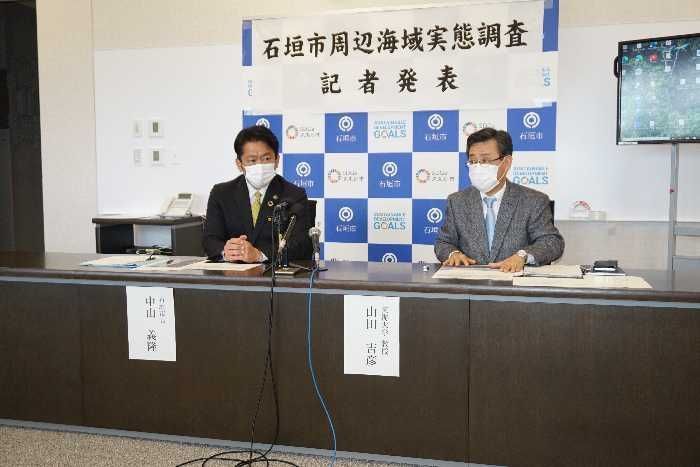
February 2, 2022 Ryukyu Shimpo
By Kenshiro Nishime
Ishigaki – Ishigaki mayor Yoshitaka Nakayama, who went to survey the Senkaku island chain on a boat with others including Tokai University professor Yoshihiko Yamada (marine affairs) on January 31, said at a press conference on February 1, “The area surrounding the Senkaku islands is under the city’s jurisdiction, however since we cannot usually approach the islands closely we took advantage of this opportunity.” In response, the city council’s opposition faction also held a press conference the same day, where they voiced their objections, stating, “We strongly object to this strong-armed unilateral inspection as a violation of international trust.”
The survey of the state of the ocean surrounding the city, which includes the Senkaku islands, was commissioned by Ishigaki City to be conducted by Tokai University. The budget for the survey was 11 million yen, and was paid for using local taxes. Around 10 Ishigaki City employees also participated in the survey. The results of the survey will help the city engage in ocean conservation efforts as well as support the local fishing industry.
Mayor Nakayama said, “We found a lot of garbage washed ashore on the coastline of Uotsuri I
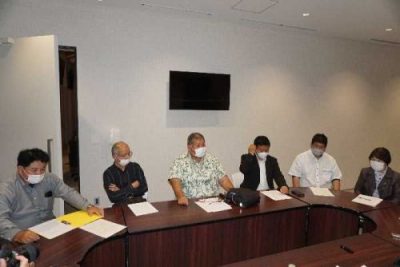
City council opposition faction members protesting Mayor Ishigaki’s survey of the ocean around the Senkaku Islands – February 1, Ishigaki City Hall
sland. Feral goats (living on the island) continue to damage vegetation on the island so it will be necessary to take action soon.” When asked for his reason for not publicly disclosing the survey beforehand, he answered, “Other countries may have tried to interfere, and we may have been unable to survey the peaceful environment.”
He also commented that he was “completely unaware” that February 1 marked the one-year anniversary of China’s Coast Guard Law. He also indicated that he was considering petitioning the central Japanese government for permission to go ashore on the islands to install a sign indicating their authority.
Meanwhile, the city council’s opposition faction also held a press conference at the city hall, where they criticized Mayor Nakayama’s survey of the Senkaku Islands. They said the survey would, “Come with the cost of damaging the Sino-Japanese relationship in an unrecoverable way,” after the Beijing Winter Olympics currently underway in China, and that “Mayor Nakayama bears a grave responsibility for the pretext [of the survey].”
They also complained that the ocean survey was not explained to the city council in the budget proposal, and said that this was a “performance” as part of the lead-up to the Ishigaki mayoral election on February 27.
(English translation by T&CT and Sam Grieb)
Go to Japanese
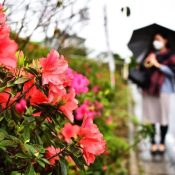
February 4, 2022 Ryukyu Shimpo
By John Matsumoto
February 4 marked the start of spring, one of the 24 solar terms of the lunar calendar. This is when the cold alleviates and spring begins. Due to a weather front on February 3, the Okinawa region had cloudy and rainy weather all day, and some sites even had tempestuous rainfall.
In a shrubbery next to the Ginoza Village Office, some rhododendron flowers, the village flower, have begun to bloom. The red and pink flowers were adorned with raindrops, calmly and brilliantly heralding in spring. In a speech, a spokesperson for the Ginoza Village General Affairs Department mentioned that, “Every year, [the flowers] begin to bloom around the time of the Hanshin Tigers training camp.”
According to the Okinawa Meteorological Observatory, it is likely that there will be many cloudy days and rainy days in the Okinawa region for the next week.
(English translation by T&CT and Erin Jones)
Go to Japanese
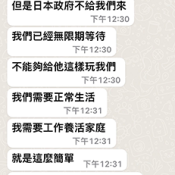
February 3, 2022 Ryukyu Shimpo
By Wu Li Jun
As a result of the continuing government restrictions on entry into Japan to prevent the spread of COVID-19, Hong Kong residents planning to migrate to Okinawa in order to invest have had to cancel their plans. At one immigration consulting firm in Okinawa, four groups (ten people) from Hong Kong have changed their destination to the United Kingdom since the start of 2021. They have also liquidated the companies they had registered in the prefecture. A representative of the consulting firm says, “It’s a huge loss for the Okinawan economy. Hopefully they will ease the restrictions on immigration soon.”
In July 2020, the Chinese government enacted the Hong Kong national security law with the goal of strengthening Chinese control of Hong Kong. In response, the number of Hong Kong residents hoping to migrate to Okinawa increased. Most of the people migrating with the help of the Okinawan immigration consulting firm sought a new home overseas because of the national security law.
According to the firm, these individuals made the decision to leave their homeland forever. They quit their jobs and sold all of their property. They stayed in hotels in Hong Kong, paying 500,000-600,000 yen per month, while they waited to enter Japan. However, as they waited without income, there was no sign of being allowed to enter Japan. Some were in limbo in Hong Kong for over a year.
The firm representative says, “People coming from Hong Kong to invest in Okinawa would have been a boon to our economy. Some of them were planning to sell Okinawan goods overseas. It’s incredibly unfortunate.”
If the entry restrictions continue to be in place, it is possible that even more overseas investors will abandon plans to move to Okinawa. The representative adds, “If these strict restrictions continue, it will impact not only investors from overseas, but also small businesses in Okinawa. I hope that the government will ease the restrictions as soon as possible, even while they continue the quarantine policy.”
(English translation by T&CT and Ellen Huntley)
Go to Japanese

February 2, 2022 Ryukyu Shimpo
By Riko Higa
On the February 1 Lunar New Year, many visitors flocked to the Itoman fishing port in Itoman City, Okinawa, to see the tairyo-bata, or fishermen’s flags indicating a big catch. Masahiro Tanaka, 78, and his wife Midori, 75, moved to Itoman City from Saitama Prefecture 12 years ago. Midori said, “We don’t have Lunar New Year’s customs [back home], so we enjoyed this occasion. We were experiencing poor weather, but we got to enjoy a nice stroll.”
The fishermen also barbequed at the port. Rei Irikedamoto, 32, captain of the Ryusei-Maru, expressed his hopes for the New Year: “The damage was limited but the pumice stones are still drifting at sea. Having no accidents is best.”
(T&CT and Monica Shingaki)
Go to Japanese
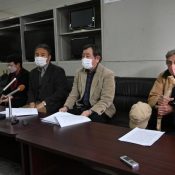
February 1, 2022 Ryukyu Shimpo
By Yuki Karimata
The “No More Okinawan War, Nuchi du Takara (Life is a Treasure)” committee, which opposes the U.S.-Japan joint defense plan to militarize the Nansei archipelago so that the Japan Self-Defense Force (JSDF) and U.S. military can attack their enemies in the case of a crisis in Taiwan, was formed on January 31. The organization stated that their fundamental plan of action would be to “Stop the Okinawan islands from becoming a battlefield once again.” The plan moving forward is to gain advocates and endorsements through events such as an organization opening ceremony and by hosting symposiums. They also plan to make appeals to Okinawa’s governor and prefectural assembly chairman.
The committee is represented by Masaie Ishihara (Okinawa International University professor emeritus), Douglas Lummis (international political scholar), Takamatsu Gushiken (war-dead remain retrieval volunteer), Akemi Miyagi (Okinawa women’s history researcher), and Hiroji Yamashiro (Okinawa Peace Action Center advisor).
The committee announced their formation at a press conference at the Okinawa Prefectural Office’s press club on January 31. Yamashiro said, “We want to gain the endorsement of many people. We also want to reach out to conservatives, and economic organizations.”
At the end of last year, the U.S. military confirmed a plan to set up an attack base along the Nansei islands in case of an emergency in Taiwan. They formed the organization with the aim of engaging in bipartisan activities calling for the revocation of this plan, with Yamashiro and researchers in Okinawa as promoters.
In order to cover operating costs, they are soliciting contributions of at least 500 yen. Contributions can be sent by direct deposit to Japan Post Bank, code 17040 no. 01742091. For contributions from financial institutions other than Japan Post Bank, the branch name is 708, the branch number is 708, deposit type is ordinary bank account, and the account number is 0174209.
(English translation by T&CT and Sam Grieb)
Go to Japanese
January 28, 2022 Ryukyu Shimpo
On January 28, citizens living in the vicinity of Kadena Air Base filed the fourth Kadena noise lawsuit, in which they are suing over noise damage from U.S. military aircraft and requesting a suspension of early morning and late night flights. The number of plaintiffs has increased to a new high of over 35,000 people.
The suspension of flights of U.S. military aircraft requested in the third Kadena noise lawsuit was pushed aside as an “act by a third party” that cannot be restricted as it is conduct by a third party (the U.S. military) not under the control of the Japanese government. However, repeated lawsuits are being filed even while coming up against a wall, and, at the same time, the number of residents joining with the plaintiffs is rising.
The expansion of the scale of the plaintiffs’ side is an earnest complaint about the current circumstances in which the residents’ right to live peacefully and safely is being threatened. The residents will feel nothing but anger for the U.S. and Japanese governments unless drastic measures are taken. If the government leaves the illegal noise damage that exceeds allowance limits as-is, the administration of justice must clearly show us the way out.
This time the court will directly confront the residents who are calling out the violation of rights.
The first lawsuit concerning the noise damage in the surroundings of Kadena Air Base was filed in 1982, the second in 2000, and the third in 2011. Although none of these lawsuits was able to achieve a suspension of U.S. military aircraft flights, the courts have acknowledged that the noise conditions “exceed the allowance limits” and are therefore illegal, and have ordered the government to provide compensation.
In the third Kadena noise lawsuit, it was determined that the Japanese government would pay 22,020 people a total of over 26,125,000,000 yen in compensation.
Of course reparations do not fundamentally solve the problem. Even if, initially, reparations are paid by the government, these end up being a tax. Causing illegal occurrences of noise is not made okay if compensation is paid. Also, because the courts do not approve future reparations, residents must repeatedly go to court to get compensation for the damage incurred.
The problem is that no effective measures are being taken to do away with the illegal noise damage. The use of Kadena Air Base has, if anything, become incessant, with the frequent addition of aircraft from off base to the aircraft stationed there. “Exceptions” to the noise abatement agreement that regulates nighttime takeoffs and landings are being allowed, and the agreement is being reduced to a formality.
The plaintiffs are making the humble request that they “want to sleep peacefully.” Article 25 of the Constitution stipulates that, “All people shall have the right to maintain the minimum standards of wholesome and cultured living.” Yet there is no relief without a suspension of the flights that are the source of the din.
This year will mark 50 years since Okinawa was returned to Japan. The people of Okinawa believed that the Constitution applied to them and that they had broken free of U.S. military control due to the return. However, the reality is that, even now, the people are oppressed under the dangers and damage caused by the U.S. military bases.
The courts do not consider this to be a problem running contrary to the U.S.-Japan Security Treaty and the rights of citizens, and has avoided judgment using act by a third party. As long as the U.S.-Japan Security Treaty is in place, Okinawa will unfortunately fall outside the scope of the Constitution. I want Okinawa to have the real sense that the Constitution exists, and an independent decision from the administration of justice.
(English translation by T&CT and Erin Jones)
Go to Japanese
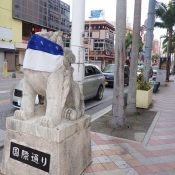
January 27, 2022 Ryukyu Shimpo
By Yosuke Anri
Tokyo – Takaji Wakita, the Ministry of Health, Labor, and Welfare coronavirus advisory board chairman, announced January 26 that the coronavirus pandemic in Okinawa “appears to have passed its peak.” He indicated that pandemic policies such as the “semi-state of emergency COVID-19 measures” were successful.
The effective reproduction number of the virus, which shows how many people a single infected person could spread the virus to, fell below a value of 1 last week to 0.8, which he views as “achieving a slight downward trend.”
By age group, cases for people in their 20’s are seeing a downward trend, however there is still an upward trend for underage people (under 20), and for those over 60, and Wakita commented “we still need to be cautious of the situation for a little longer.”
Wakita said at a press conference after the board meeting, he indicated a cautious stance with regards to the early termination of the semi-state of emergency COVID-19 measures, stating, “The speed at which this is resolving is slow. If we do not keep a careful watch of the situation a little while longer, it will be hard to determine.”
(English translation by T&CT and Sam Grieb)
Go to Japanese

January 26, 2022 Ryukyu Shimpo
At the Nakijin Castle Ruins in Nakijin, Yaedake in Motobu, and the Nago Castle Ruins in Nago, the Hikanzakura (Taiwan cherry) trees are in bloom. At Yaedake, the cherry blossom festival started on January 22. Sakuranomori Park at Yaedake will be illuminated every night through February 6 so that visitors can enjoy the blossoms at night as well (photos of the festival will be featured in the municipalities section of the paper on January 28).
At the Nakijin Castle Ruins, approximately 70% of the flowers are in bloom already. The Nakijin Cherry Blossom Festival starts on January 29. The night-time cherry blossom illumination happens every year, but this year will take place without visitors. Instead, the illumination will only be accessible online on January 29 and 30, and February 5 and 6. For more details, visit the festival home page.
At Nago Castle Ruins, a mother and daughter enjoying the blossoms and taking pictures commented, “We want to relax by looking at the cherry blossoms.”
(English translation by T&CT and Ellen Huntley)
Go to Japanese

January 24, 2022 Ryukyu Shimpo
By Naoki Isa
Through January 30, the Naha Giant Tug-of-War Preservation Society is raising funds for the 52nd Naha Tug-of-War event slated for October 9 on the crowdfunding website Makuake. The organization has struggled with the event operation as donations slowed down during the pandemic, adding to the higher-than-expected costs associated with discarding the previous giant rope which was replaced in 2020. As a thank-you gift for the donations, the preservation society will give away kari-ropes, or the reins of the giant rope, at the end of this year’s tug-of-war event.
The 2020 and 2021 Naha Tug-of-War events were canceled as a precaution against Covid-19. The preservation association is asking for the public’s cooperation in ensuring the event is held in 2022. To find out more about the crowdfunding initiative, search the phrases “Naha Tug of War” and “Makuake” online.
(English translation by T&CT and Monica Shingaki)
Go to Japanese

January 24, 2022 Ryukyu Shimpo
Incumbent Taketoyo Toguchi has won reelection in the Nago mayoral race, in which the relocation of MCAS Futenma to the Henoko area of Nago became a major battleground issue.
This mayoral election was the first since the confirmation of soft ground at the bottom of Oura Bay. Also, as the first mayoral election since the prefectural referendum in 2019, where 70% of voters opposed land reclamation in Henoko, the race had gained attention as a view into the direction of public opinion in Nago.
However, the defeat of newcomer Yohei Kishimoto, who opposes the base relocation, cannot be said to be an approval of the new base construction by Nago City residents. While winning reelection, Toguchi has yet to make clear his stance on new base construction, only commenting, “There is nothing we can do other than to closely follow developments between the central and Okinawa government.”
This is a point that the central government should fully bear in mind. It has not changed the fact that they should take into consideration the overwhelming opposition to relocation by Okinawans, and that they should immediately stop new base construction.
In fact, residents of Nago have an even more negative view of the relocation. In a telephone survey conducted January 16-17 in a combined effort from the Ryukyu Shimpo, the Okinawa Times, and the Kyodo News Service, 62.1% of respondents said that they either “Oppose” or “If I had to choose one, oppose” the base relocation, while only 33.2% said they “Approve” or “If I had to choose one, approve.”
Additionally, regarding the decision of Okinawa Prefecture to revoke permission for the design change to improve the soft ground, including the “If I had to choose one” responses, 57% supported the decision far surpassing the 33.3% who did not support it.
Furthermore, the Komeito party in Okinawa, which supported Toguchi, opposes the Henoko relocation. Toguchi should not forget this after receiving so many votes from Komeito party members.
In the election, other pressing issues such as coronavirus measures, economic promotion, education and childcare, maintenance of the Hokubu Kikan Hospital, and social security and elderly care. For many people, these issues far outweighed the base issue in importance for this election.
It goes without saying that the election’s results take into account a variety of thoughts from the voters. We certainly want Toguchi, who has earned the trust of the people of Nago, to fulfill his campaign promises of promoting a prosperous life for the people of his city.
This year is a year of elections for Okinawa. In the summer there is an election for the House of Councillors, followed by nationwide local elections, and then peaks with the crucial gubernatorial election in the fall. Toguchi’s victory in this first pivotal battle is a big momentum builder for the Liberal Democratic Party (LDP) and Komeito Party’s coalition to increase their political power in Okinawa.
Meanwhile, for the “All Okinawa” faction, which supports Okinawa governor Denny Tamaki and opposes the base relocation, it is a hard loss after also losing in the Nanjo mayoral election. They will need to revamp their efforts and rethink their strategy for the elections to come.
(English translation by T&CT and Sam Grieb)
Go to Japanese

January 21, 2022 Ryukyu Shimpo
By Takaya Kinra
On January 20 in a press conference held online, it was announced that 508 people (from 165 households) will be filing additional actions with the Okinawa branch of the Naha District Court on January 25 as part of the third Kadena noise lawsuit, in which a substantial ban on flights of U.S. military aircraft taking off from and landing at Futenma Air Station in Ginowan City as well as damages for harm incurred by the aircraft noise are requested. Now, with the addition of these 508 people, the number of plaintiffs has reached its highest number yet at a total of 5,846 people (from 2,110 households) since the lawsuit started in December 2020.
Successive inquiries from local residents concerning foreign aircraft flying into Futenma Air Station and other such concerns resulted in a round of additional actions as part of the third Kadena Noise lawsuit. Said round of actions stretched into March 2021 and has since been concluded.
Plaintiffs in the third Kadena noise lawsuit range from children who are not yet one year old to people in their 90s. Looking at the age categories of the plaintiffs, the largest category are people in their 40s (considered to be the child-rearing generation) accounting for 813 people (13.89 percent of the total), while plaintiffs in their 50s account for 735 people (12.55 percent), and so on. New participants from the Ogido region of Kitanakagusuku Village have joined the lawsuit for the newly announced round of additional actions.
The leader of the plaintiffs’ team of lawyers, Seiryo Arakaki, touched on the successive incidents of objects falling from U.S. military aircraft and said, “No matter what it takes, we want to effect a ban on flights and bring about the closure [of Futenma Air Station] as soon as possible.”
(English translation by T&CT and Erin Jones)
Go to Japanese











 Webcam(Kokusai Street)
Webcam(Kokusai Street)


